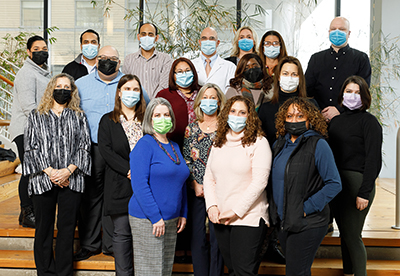-
Services
Featured Specialties
-
Locations
Location Type
-
Patients & Visitors

YNHHS’ Infection Prevention staff, including the Yale New Haven Hospital team, work closely with other employees and departments to keep patients and staff safe from an array of ever-evolving microbes and other hazards.
Kathy Krechevsky, infection preventionist, never knows what she will encounter at work. It’s one of the reasons she loves what she does.
“Our job is always different,” said Krechevsky. “It’s always exciting, and there’s always something to learn. Every day is a new adventure.”
Krechevsky is one of 32 staff members in Infection Prevention (IP), a health system department that provides 24/7 coverage to all five hospitals and more than 100 ambulatory sites.
The field of infection prevention has received a lot of attention during the COVID-19 pandemic, but formalized surveillance and control programs have existed in U.S. hospitals since the 1970s. Programs were established to track and combat hospital-acquired infections (HAIs), which continue to be priorities for YNHHS’ Infection Prevention department.
While they focus on central line-associated bloodstream infections (CLABSIs), catheter-associated urinary tract infections (CAUTIs), surgical site infections (SSIs) and resistant and emerging pathogens, department staff have numerous other duties. These include everything from providing guidance on the size of gatherings, to ensuring the health system meets a myriad of infection prevention-related regulatory agency requirements, to safeguarding patients and staff from potential dust-related hazards during hospital construction projects.
“We are a cornerstone of the institution,” said Donna Nucci, RN, YNHHS director of IP. “We are a resource for every department.”
Paul Gentile, infection preventionist, started his infection prevention career six years ago, after earning his master’s in public health. Most of YNHHS’ infection preventionists have public health graduate degrees or degrees in nursing or laboratory microbiology. All infection preventionists undergo “very extensive on-the-job training,” said Michael Aniskiewicz, IP manager. They must become board-certified in infection prevention after two years and re-certified every five years.
While there is no such thing as a “typical day” for an infection preventionist, Gentile said, he usually starts by reviewing lab cultures. He then rounds in the areas he covers – Cardiology and Radiology – to review patients with invasive devices and those on isolation precautions. He’ll also help resolve any environment-of-care issues such as cleanliness or supplies storage and assist staff with infection prevention-related matters.
“It’s such a dynamic role,” Gentile said. “We touch every aspect of health care, ranging from consulting with clinical staff on care bundles, to investigating an outbreak of an infection on a unit, to looking at the air exchange, temperature and humidity levels in the operating rooms.”
He and other department staff emphasized that their role is not to “police” staff, but to be a resource, providing information and support. It’s a two-way street.
“The critical piece in being effective is partnering with other departments and staff,” said Richard Martinello, MD, medical director, IP, Yale New Haven Hospital and Yale New Haven Health. “We’re all working to create a safe environment for patients and staff, and to create a better healthcare system for our patients and our families.”
He and other department staff stressed that Infection Prevention cannot do this alone.
“It is vital for departments at YNHHS to involve their infection preventionists in any IP-related activities,” Gentile said.
Staff can find out who their designated infection preventionist is by visiting the IP department page on the employee intranet.
“All employees have the power to affect infection prevention,” Krechevsky said. “Our department provides the expertise, and the hospital provides the resources. However, employees have the power to educate themselves; follow protocols to protect themselves, patients and other staff; and reach out to their leadership and Infection Prevention with any concerns. In this way, we are all equal partners for infection prevention safety.”